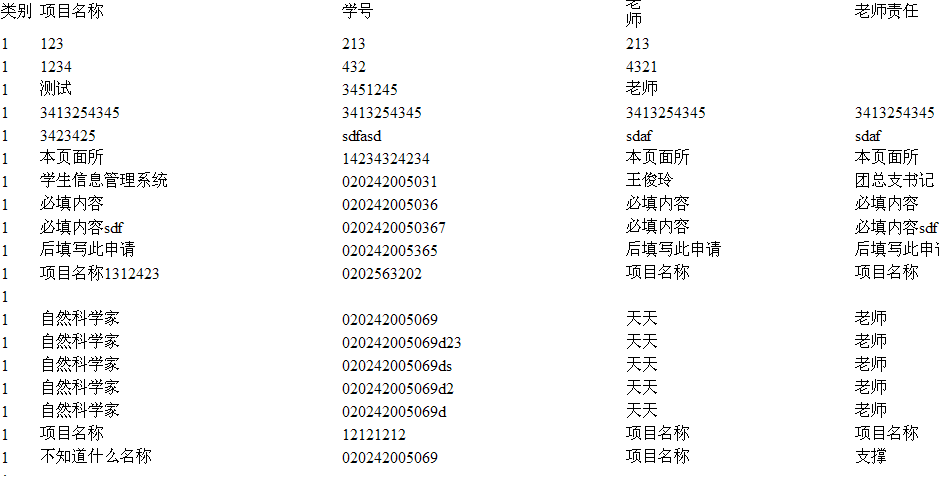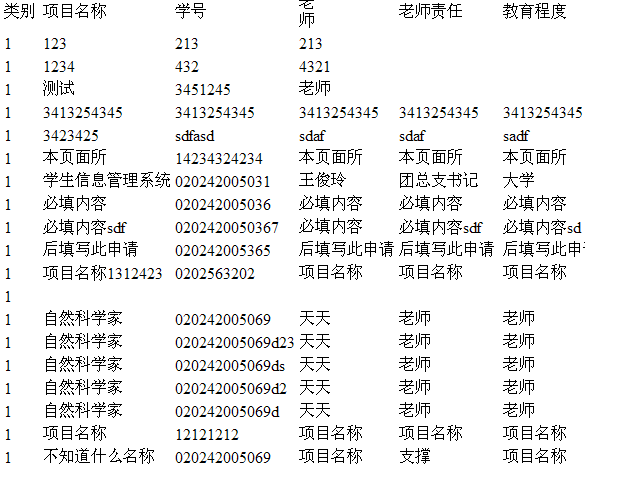Xml
的好处自然有很多,在软件中用xml可以让软件方便的实现多语言版,在数据传输中它能够以很好的组织结构交换信息,同时利用xpath可以方便的解析,在持久化中它能很好的描述业务数据……本文主要讲通过读取xml配置实现对不同数据实体的统一处理,生成表现table,当然生成div也是可以的。以table为例。
代码中没有进行异常处理,请见谅,只是写出了思路!
xml文件:
 <?xml version="1.0" encoding="utf-8" ?>
<?xml version="1.0" encoding="utf-8" ?> <ListConfig>
<ListConfig> <!-- 项目table的模板一 type标识模板,attribute定义table或者td的属性,name与数据表的列名对应 -->
<!-- 项目table的模板一 type标识模板,attribute定义table或者td的属性,name与数据表的列名对应 --> <Project type="0" attribute="width='100%'">
<Project type="0" attribute="width='100%'"> <Column name="Sort" attribute="width='35'">类别</Column>
<Column name="Sort" attribute="width='35'">类别</Column> <Column name="ProjectName" attribute="width='100'">项目名称</Column>
<Column name="ProjectName" attribute="width='100'">项目名称</Column> <Column name="StudentNum" attribute="width='40'">学号</Column>
<Column name="StudentNum" attribute="width='40'">学号</Column> <Column name="Teacher" attribute="width='30'">老师</Column>
<Column name="Teacher" attribute="width='30'">老师</Column> <Column name="TeacherDuty" attribute="width='100'">老师责任</Column>
<Column name="TeacherDuty" attribute="width='100'">老师责任</Column> </Project>
</Project> <!-- 项目table的模板二 -->
<!-- 项目table的模板二 --> <Project type="1" attribute="">
<Project type="1" attribute=""> <Column name="Sort" attribute="width='35'">类别</Column>
<Column name="Sort" attribute="width='35'">类别</Column> <Column name="ProjectName" attribute="width='100'">项目名称</Column>
<Column name="ProjectName" attribute="width='100'">项目名称</Column> <Column name="StudentNum" attribute="width='40'">学号</Column>
<Column name="StudentNum" attribute="width='40'">学号</Column> <Column name="Teacher" attribute="width='30'">老师</Column>
<Column name="Teacher" attribute="width='30'">老师</Column> <Column name="TeacherDuty" attribute="width='100'">老师责任</Column>
<Column name="TeacherDuty" attribute="width='100'">老师责任</Column> <Column name="EduLevel" attribute="width='100'">教育程度</Column>
<Column name="EduLevel" attribute="width='100'">教育程度</Column> </Project>
</Project> <!-- 项目table的模板三 -->
<!-- 项目table的模板三 --> <Project type="2" attribute="">
<Project type="2" attribute=""> <Column name="ProjectName" attribute="width='100'">项目名称</Column>
<Column name="ProjectName" attribute="width='100'">项目名称</Column> <Column name="StudentNum" attribute="width='40'">学号</Column>
<Column name="StudentNum" attribute="width='40'">学号</Column> <Column name="Teacher" attribute="width='30'">老师</Column>
<Column name="Teacher" attribute="width='30'">老师</Column> </Project>
</Project> <Article type="0" attribute="">
<Article type="0" attribute=""> <Column name="Title" attribute="">标题</Column>
<Column name="Title" attribute="">标题</Column> <Column name="Content" attribute="">内容</Column>
<Column name="Content" attribute="">内容</Column> <Column name="Author" attribute="">作者</Column>
<Column name="Author" attribute="">作者</Column> <Column name="ComeFrom" attribute="">来源</Column>
<Column name="ComeFrom" attribute="">来源</Column> </Article>
</Article> </ListConfig>
</ListConfig>Code:
 public class ConstructEntityList<T> where T : class, new()
public class ConstructEntityList<T> where T : class, new()

 {
{ private Type tType;
private Type tType; private XmlDocument document = new XmlDocument();
private XmlDocument document = new XmlDocument();
 public ConstructEntityList()
public ConstructEntityList()

 {
{  //获得要生成的列表对应的实体类型
//获得要生成的列表对应的实体类型 tType = typeof(T);
tType = typeof(T); //加载配置文件
//加载配置文件 document.Load(@"D:\PracticeAndTeach\PracticeAndTeach\PATWebSite\Component\ListConfig.xml");
document.Load(@"D:\PracticeAndTeach\PracticeAndTeach\PATWebSite\Component\ListConfig.xml"); }
}
 /**//// <summary>
/**//// <summary> /// 获得实体列表table
/// 获得实体列表table /// </summary>
/// </summary> /// <param name="iqueryable">转换源</param>
/// <param name="iqueryable">转换源</param> /// <param name="type">模板类型</param>
/// <param name="type">模板类型</param> /// <returns>table</returns>
/// <returns>table</returns> public string GetEntityListString(IQueryable<T> iqueryable, object type)
public string GetEntityListString(IQueryable<T> iqueryable, object type)

 {
{ //得到模板的列元素
//得到模板的列元素 XmlNodeList list = document.SelectNodes(string.Format("/ListConfig/{0}[@type={1}]/Column",tType.Name, Convert.ToInt32(type)));
XmlNodeList list = document.SelectNodes(string.Format("/ListConfig/{0}[@type={1}]/Column",tType.Name, Convert.ToInt32(type))); StringBuilder listBuilder = new StringBuilder();
StringBuilder listBuilder = new StringBuilder(); //构造table的表头,并且设置table的属性
//构造table的表头,并且设置table的属性 listBuilder.AppendFormat("<table {0} ><tr>",
listBuilder.AppendFormat("<table {0} ><tr>", document.SelectSingleNode(string.Format("/ListConfig/{0}[@type={1}]",tType.Name, Convert.ToInt32(type))).Attributes.GetNamedItem("attribute").Value);
document.SelectSingleNode(string.Format("/ListConfig/{0}[@type={1}]",tType.Name, Convert.ToInt32(type))).Attributes.GetNamedItem("attribute").Value); for (int i = 0; i < list.Count; i++)
for (int i = 0; i < list.Count; i++)

 {
{ listBuilder.AppendFormat("<td {1}>{0}</td>", list.Item(i).InnerText, list.Item(i).Attributes.GetNamedItem("attribute").Value);
listBuilder.AppendFormat("<td {1}>{0}</td>", list.Item(i).InnerText, list.Item(i).Attributes.GetNamedItem("attribute").Value); }
} listBuilder.Append("</tr>");
listBuilder.Append("</tr>");
 PropertyInfo info;
PropertyInfo info; //遍历数据源,通过xml配置文件得到需要读取的实体属性,利用反射得到属性值
//遍历数据源,通过xml配置文件得到需要读取的实体属性,利用反射得到属性值 foreach (T t in iqueryable)
foreach (T t in iqueryable)

 {
{ listBuilder.Append("<tr>");
listBuilder.Append("<tr>"); for (int i = 0; i < list.Count; i++)
for (int i = 0; i < list.Count; i++)

 {
{ info = tType.GetProperty(list.Item(i).Attributes.GetNamedItem("name").Value);
info = tType.GetProperty(list.Item(i).Attributes.GetNamedItem("name").Value); listBuilder.AppendFormat("<td>{0}</td>", info.GetValue(t, null));
listBuilder.AppendFormat("<td>{0}</td>", info.GetValue(t, null)); }
} listBuilder.Append("</tr>");
listBuilder.Append("</tr>"); }
} listBuilder.Append("</table>");
listBuilder.Append("</table>"); return listBuilder.ToString();
return listBuilder.ToString(); }
} }
}应用:
调用第一种xml配置
new ConstructEntityList<Project>().GetEntityListString((from s in patDataContext.Projects select s), ProjectList.Default);
结果:

调用第二种xml配置
new ConstructEntityList<Project>().GetEntityListString((from s in patDataContext.Projects select s), ProjectList.More);
结果:

好处:不需要修改源代码,通过对xml配置文件的修改就可以实现table列表值的改变
场景:在项目管理系统中对于普通用户只需要看到项目名称,项目概述,负责人;对于管理者需要看到项目名称,项目概述,负责人,项目进度,项目成果;哪么我们只需要对不同情况定制一个xml块,生成列表时只要指定实用那个xml块哪么显示内容自动改变。





















 被折叠的 条评论
为什么被折叠?
被折叠的 条评论
为什么被折叠?








